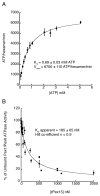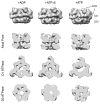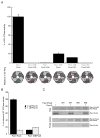The Pex1/Pex6 complex is a heterohexameric AAA+ motor with alternating and highly coordinated subunits
- PMID: 25659908
- PMCID: PMC4355278
- DOI: 10.1016/j.jmb.2015.01.019
The Pex1/Pex6 complex is a heterohexameric AAA+ motor with alternating and highly coordinated subunits
Abstract
Pex1 and Pex6 are Type-2 AAA+ ATPases required for the de novo biogenesis of peroxisomes. Mutations in Pex1 and Pex6 account for the majority of the most severe forms of peroxisome biogenesis disorders in humans. Here, we show that the ATP-dependent complex of Pex1 and Pex6 from Saccharomyces cerevisiae is a heterohexamer with alternating subunits. Within the Pex1/Pex6 complex, only the D2 ATPase ring hydrolyzes ATP, while nucleotide binding in the D1 ring promotes complex assembly. ATP hydrolysis by Pex1 is highly coordinated with that of Pex6. Furthermore, Pex15, the membrane anchor required for Pex1/Pex6 recruitment to peroxisomes, inhibits the ATP-hydrolysis activity of Pex1/Pex6.
Keywords: AAA+ ATPase; Pex1; Pex15; Pex6; peroxisome.
Copyright © 2015 Elsevier Ltd. All rights reserved.
Figures






Similar articles
-
The peroxisomal AAA-ATPase Pex1/Pex6 unfolds substrates by processive threading.Nat Commun. 2018 Jan 10;9(1):135. doi: 10.1038/s41467-017-02474-4. Nat Commun. 2018. PMID: 29321502 Free PMC article.
-
The N1 domain of the peroxisomal AAA-ATPase Pex6 is required for Pex15 binding and proper assembly with Pex1.J Biol Chem. 2024 Jan;300(1):105504. doi: 10.1016/j.jbc.2023.105504. Epub 2023 Nov 29. J Biol Chem. 2024. PMID: 38036174 Free PMC article.
-
Molecular snapshots of the Pex1/6 AAA+ complex in action.Nat Commun. 2015 Jun 12;6:7331. doi: 10.1038/ncomms8331. Nat Commun. 2015. PMID: 26066397 Free PMC article.
-
Insights into the Structure and Function of the Pex1/Pex6 AAA-ATPase in Peroxisome Homeostasis.Cells. 2022 Jun 29;11(13):2067. doi: 10.3390/cells11132067. Cells. 2022. PMID: 35805150 Free PMC article. Review.
-
Structures of the double-ring AAA ATPase Pex1-Pex6 involved in peroxisome biogenesis.FEBS J. 2016 Mar;283(6):986-92. doi: 10.1111/febs.13569. Epub 2015 Nov 12. FEBS J. 2016. PMID: 26476099 Free PMC article. Review.
Cited by
-
Structural Mapping of Missense Mutations in the Pex1/Pex6 Complex.Int J Mol Sci. 2019 Aug 1;20(15):3756. doi: 10.3390/ijms20153756. Int J Mol Sci. 2019. PMID: 31374812 Free PMC article. Review.
-
Hansenula polymorpha Aat2p is targeted to peroxisomes via a novel Pex20p-dependent pathway.FEBS Lett. 2018 Jul;592(14):2466-2475. doi: 10.1002/1873-3468.13168. Epub 2018 Jun 30. FEBS Lett. 2018. PMID: 29924881 Free PMC article.
-
Structure and Function of p97 and Pex1/6 Type II AAA+ Complexes.Front Mol Biosci. 2017 May 29;4:33. doi: 10.3389/fmolb.2017.00033. eCollection 2017. Front Mol Biosci. 2017. PMID: 28611990 Free PMC article. Review.
-
Shedding light on the expansion and diversification of the Cdc48 protein family during the rise of the eukaryotic cell.BMC Evol Biol. 2016 Oct 18;16(1):215. doi: 10.1186/s12862-016-0790-1. BMC Evol Biol. 2016. PMID: 27756227 Free PMC article.
-
Peroxisomal targeting of a protein phosphatase type 2C via mitochondrial transit.Nat Commun. 2020 May 12;11(1):2355. doi: 10.1038/s41467-020-16146-3. Nat Commun. 2020. PMID: 32398688 Free PMC article.
References
-
- Tabak HF, Braakman I, van der Zand A. Peroxisome formation and maintenance are dependent on the endoplasmic reticulum. Annu Rev Biochem. 2013;82:723–44. - PubMed
-
- Weller S, Gould SJ, Valle D. Peroxisome biogenesis disorders. Annu Rev Genomics Hum Genet. 2003;4:165–211. - PubMed
-
- Schluter A, Fourcade S, Ripp R, Mandel JL, Poch O, Pujol A. The evolutionary origin of peroxisomes: an ER-peroxisome connection. Mol Biol Evol. 2006;23:838–45. - PubMed
-
- Hoepfner D, Schildknegt D, Braakman I, Philippsen P, Tabak HF. Contribution of the endoplasmic reticulum to peroxisome formation. Cell. 2005;122:85–95. - PubMed
Publication types
MeSH terms
Substances
Grants and funding
LinkOut - more resources
Full Text Sources
Other Literature Sources
Molecular Biology Databases

